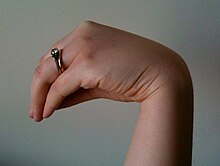Trousseau sign of latent tetany: Difference between revisions
m Made a note on the error of the image, that the DIP and PIP joints should be extended, not in flexion. |
|||
| Line 1: | Line 1: | ||
[[Image:Troussau's Sign of Latent Tetany.jpg|thumb |
[[Image:Troussau's Sign of Latent Tetany.jpg|thumb|A hand being held similarly to Trousseau's sign. In this image, the DIP and PIP joints are mistakenly in flexion.|alt=]]{{distinguish|text=[[Trousseau sign of malignancy|Trousseau syndrome]]}}'''Trousseau sign of latent tetany''' is a [[medical sign]] observed in patients with low [[calcium]].<ref>Kumar, Abbas, Fausto. ''Pathologic Basis of Disease, 7th edition.'' Philadelphia: Elsevier-Saunders, 2005. 1188.</ref> From 1 to 4 percent of normal patients will test positive for Trousseau's sign of latent tetany.<ref>{{cite book|author=Dennis, Mark|author2=Bowen, William Talbot|author3=Cho, Lucy|chapter=Trousseau's sign|chapter-url=https://books.google.com/books?id=FIV-NYPRCzEC&pg=PA555|title=Mechanisms of Clinical Signs|year=2012|publisher=Elsevier|page=555|isbn=978-0729540759|postscript=; pbk}}</ref> This sign may be positive before other manifestations of [[hypocalcemia]] such as [[hyperreflexia]] and [[tetany]], as such it is generally believed to be more [[Sensitivity and specificity#Sensitivity|sensitive]] (94%) than the [[Chvostek sign]] (29%) for hypocalcemia.<ref name="pmid4952674">{{cite journal|last=Fonseca|first=OA|author2=Calverley, JR |title=Neurological manifestations of hypoparathyroidism.|journal=Archives of Internal Medicine|date=August 1967|volume=120|issue=2|pages=202–6|doi=10.1001/archinte.1967.00300020074009|pmid=4952674}}</ref><ref>Schaat M, Payne CA. Effect of diphenylhydantoin and phenobarbital on latent tetany</ref> |
||
To elicit the sign, a [[blood pressure cuff]] is placed around the arm and inflated to a pressure greater than the [[systolic blood pressure]] and held in place for 3 minutes. This will occlude the [[brachial artery]]. In the absence of blood flow, the patient's hypocalcemia and subsequent neuromuscular irritability will induce spasm of the muscles of the hand and forearm. The wrist and [[metacarpophalangeal joint]]s flex, the [[distal interphalangeal joint|DIP]] and [[proximal interphalangeal joint|PIP]] joints extend, and the fingers [[adduction|adduct]]. The sign is also known as '''''main d'accoucheur''''' ([[French language|French]] for "''hand of the [[obstetrician]]''") because it supposedly resembles the position of an obstetrician's hand in delivering a baby. |
To elicit the sign, a [[blood pressure cuff]] is placed around the arm and inflated to a pressure greater than the [[systolic blood pressure]] and held in place for 3 minutes. This will occlude the [[brachial artery]]. In the absence of blood flow, the patient's hypocalcemia and subsequent neuromuscular irritability will induce spasm of the muscles of the hand and forearm. The wrist and [[metacarpophalangeal joint]]s flex, the [[distal interphalangeal joint|DIP]] and [[proximal interphalangeal joint|PIP]] joints extend, and the fingers [[adduction|adduct]]. The sign is also known as '''''main d'accoucheur''''' ([[French language|French]] for "''hand of the [[obstetrician]]''") because it supposedly resembles the position of an obstetrician's hand in delivering a baby. |
||
Revision as of 01:56, 27 December 2018

Trousseau sign of latent tetany is a medical sign observed in patients with low calcium.[1] From 1 to 4 percent of normal patients will test positive for Trousseau's sign of latent tetany.[2] This sign may be positive before other manifestations of hypocalcemia such as hyperreflexia and tetany, as such it is generally believed to be more sensitive (94%) than the Chvostek sign (29%) for hypocalcemia.[3][4]
To elicit the sign, a blood pressure cuff is placed around the arm and inflated to a pressure greater than the systolic blood pressure and held in place for 3 minutes. This will occlude the brachial artery. In the absence of blood flow, the patient's hypocalcemia and subsequent neuromuscular irritability will induce spasm of the muscles of the hand and forearm. The wrist and metacarpophalangeal joints flex, the DIP and PIP joints extend, and the fingers adduct. The sign is also known as main d'accoucheur (French for "hand of the obstetrician") because it supposedly resembles the position of an obstetrician's hand in delivering a baby.
The sign is named after French physician Armand Trousseau who described the phenomenon in 1861.[5] It is distinct from the Trousseau sign of malignancy.
References
- ^ Kumar, Abbas, Fausto. Pathologic Basis of Disease, 7th edition. Philadelphia: Elsevier-Saunders, 2005. 1188.
- ^ Dennis, Mark; Bowen, William Talbot; Cho, Lucy (2012). "Trousseau's sign". Mechanisms of Clinical Signs. Elsevier. p. 555. ISBN 978-0729540759; pbk
{{cite book}}: CS1 maint: postscript (link) - ^ Fonseca, OA; Calverley, JR (August 1967). "Neurological manifestations of hypoparathyroidism". Archives of Internal Medicine. 120 (2): 202–6. doi:10.1001/archinte.1967.00300020074009. PMID 4952674.
- ^ Schaat M, Payne CA. Effect of diphenylhydantoin and phenobarbital on latent tetany
- ^ Trousseau a. Clinique médicale de l'Hôtel-Dieu de Paris. Paris, 1861. Volume 2: 112-114.
Template:Eponymous medical signs for endocrinology
